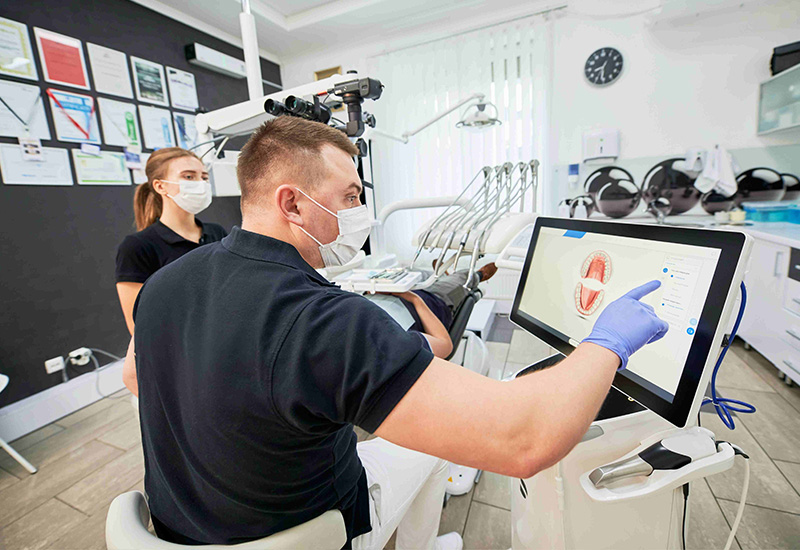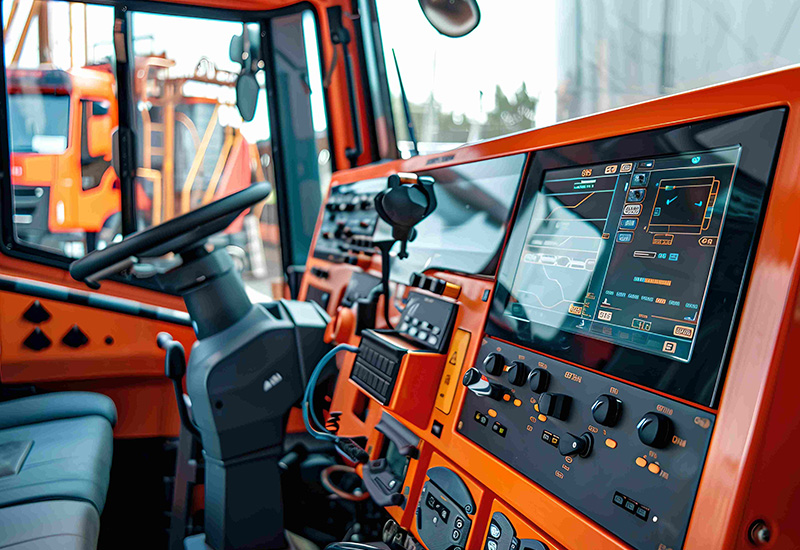CAPABILITY
NEWS CENTER
APPLICATIONS
SOLUTIONS
SUPPORT
TOUCHPANEL BLOG
CONTACT US
Resistive Touchscreens: The Pragmatic Choice for Industrial Reliability
12 Nov. 2025
In the field, high performance doesn't necessitate high cost. Resistive touchscreens leverage simple, reliable pressure-sensing technology and have long been adopted across industrial automation, medical devices, and public terminals. They can be operated with fingers, styluses, or even gloved hands—meaning they are tool-agnostic and resilient to environmental interference—making them ideal for scenarios that demand ruggedness and operational flexibility. Need a touch solution that’s reliably deployable, easy to maintain, and cost-effective? A resistive touchscreen is the pragmatic choice.
In this technology-driven era, understanding the fundamentals of resistive touch isn’t just about learning—it helps you make the right decision. This article begins with its operating mechanism and key components, then expands into comparisons with capacitive touch, typical applications, and future trends. Whether you’re a DIY enthusiast, a project manager, or an engineer focused on stable deployment, you’ll find practical takeaways here.
Resistive touch is pressure-driven: the panel consists of two layers of transparent conductive material (typically Indium Tin Oxide, ITO) separated by micro-spacers. When external force is applied, the top flexible film bends to contact the bottom layer, causing a change in resistance. The touch controller reads these changes and converts them into coordinate signals—registering the touch. Because it doesn’t rely on the body’s electrostatic field, it supports input via fingers, styluses, gloves, and even non-conductive tools, offering high operational flexibility.
Operating Mechanism
Key Components
| Component Name | Material/Specification | Function |
|---|---|---|
| Top Layer | PET Flexible Transparent Film | User contact interface; balances flexibility and light transmittance |
| Spacers/Adhesive | N/A | Maintains layer separation; ensures linearity and accuracy |
| Substrate | Glass or Hard Plastic | Provides structural rigidity and long-term stability |
| Resistive Coating | ITO (Indium Tin Oxide) | High transparency with good conductivity |
| Bus Bar | Conductive Strip | Reliably routes signals to the controller |
| Touch Controller | N/A | Filtering, calibration, and coordinate conversion |
Resolution and Lifespan
Current resistive panels support resolutions up to 4096×4096—more than adequate for single-point touch and precise positioning. As for lifespan, while the flexible surface and ITO coating can be prone to scratches and wear, nano protective coatings, surface hardening, or alternative materials (e.g., conductive polymers) can significantly improve scratch resistance and durability, extending overall service life.
Because it delivers usability, durability, and easy integration in one package. Starting with cost, resistive technology has a low manufacturing barrier and a mature supply chain—when scaled to ATMs, vending machines, appliances, or mass deployments, the total cost curve looks best. Next is input flexibility: use fingers, a stylus, or even thick gloves with precise control—ideal for industrial, medical, and outdoor conditions.
Environmental adaptability is another strength. Sealed designs provide effective dust and moisture protection, with stable resistance to electromagnetic interference. That means on factory lines or in commercial kitchens—high-interference environments—operation remains accurate and uninterrupted. Durability is also proven: panels are built for high-frequency presses, with common ratings of millions of touch cycles, extending maintenance intervals and reducing downtime risk.
Finally, integration efficiency. Mainstream systems like Windows, Linux, and Android offer mature support; USB or serial interfaces are plug-and-play, with abundant driver resources—making development and rollout more straightforward. The takeaway: when your product must run reliably in the real world while controlling BOM costs, resistive touch is the pragmatic, high-value choice.
| Advantage | Specific Benefit | Applicable Scenarios |
|---|---|---|
| Cost-Effective | Low manufacturing cost; mature supply chain | ATMs, Vending Machines, Appliances, Large-scale Deployments |
| Flexible Input | Supports fingers, styluses, and gloved operation | Industrial, Medical, Outdoor Environments |
| Environmental Immunity | Sealed design resists dust/moisture; strong EMI resistance | Factories, Commercial Kitchens, High-Interference Areas |
| High Durability | Withstands high-frequency pressing | Long-life equipment |
| Easy Integration | Windows/Linux/Android support | Plug-and-play applications |
Choosing a touch technology means aligning usage scenarios with product goals. The following differences provide a clear comparison to help you decide quickly:
| Comparison | Resistive | Capacitive |
|---|---|---|
| Sensitivity | Pressure-sensing; supports stylus and gloves | Human electrostatic field; excellent multi-touch |
| Resolution & Visuals | Multi-layer stack slightly reduces transmittance; brightness/contrast a bit lower | High transmittance, strong brightness, clear visuals |
| Durability | Flexible surface resists pressure but scratches more easily | Glass surface resists scratches but is relatively brittle |
| Environmental Fit | Good sealing; resists dust, moisture, and EMI | Water and humidity may affect sensing |
| Cost-Effectiveness | Lower overall cost | Higher unit price; superior interaction |
Resistive touchscreens are already embedded throughout daily life and industrial environments. Their core value lies in durability, immunity to interference, cost control, and tolerance for varied operating conditions—stable operation with gloves, wet hands, oil, or strong electrical noise. Walk into a factory and you’ll see them on HMI control panels—for example, 7-inch industrial displays—where long-term uptime and signal integrity are paramount. In POS and retail, restaurant ordering systems and cash registers rely on intuitive operation and ruggedness, keeping maintenance simple and downtime low. In medical settings, from patient monitors to clinical devices, the ability to operate reliably with gloves helps reduce cross-contamination risk.


Public information terminals like ATMs, vending machines, and kiosks subject modules to endurance tests with constant tapping and environmental fluctuation—resistive wins here with durability and predictable behavior. For entry-level developers and education, kits such as 2.8-inch TFT LCD adapter boards reduce the learning curve, making them a top choice for DIY and prototyping. In home appliances, adding touch to smart microwaves and washing machines makes operation more intuitive while differentiating products. In automotive systems—from cluster navigation to in-cabin controls—resistive touch maintains reliable performance despite temperature swings and vibration, a key reason it’s repeatedly validated for in-vehicle use.


In short: when your priorities are usability, durability, and interference immunity—not flashy multi-finger gestures or maximum optical clarity—resistive touch is the steady solution that quietly upholds the user experience. From industrial and medical to automotive, public information, and consumer prototyping, it’s already everywhere.
Resistive Touchscreen Application Overview
| Application Field | Specific Products | Key Requirements |
|---|---|---|
| Industrial | Factory control panels, HMI interfaces | Stability and anti-interference |
| POS Retail | Restaurant ordering terminals, cash registers | Simple operation, easy maintenance |
| Medical | Patient monitors, clinical equipment | Gloved operation, reduced contamination |
| Public Equipment | ATMs, vending machines, kiosks | Long-term operation, durability first |
| Consumer Electronics | 2.8-inch TFT LCD adapter boards | Entry-friendly, low learning curve |
| Home Appliances | Smart microwaves, washing machines | Intuitive operation, product differentiation |
| Automotive | Dashboard navigation, in-car controls | Reliable under temperature/vibration extremes |
Evolution Continues: The Next Chapter for Resistive Touch
Though resistive touch is a mature technology, it has not stood still—it continues to advance in key areas. First, resolution: from conductive layers to control algorithms, improvements are pushing panels toward higher pixel densities, making Full HD and even 4K displays feasible. Materials are evolving too: silver nanowires, conductive polymers, and multi-layer hard coatings are increasingly adopted, delivering better scratch resistance, weatherability, and sustainability while reducing reliance on ITO. Technology boundaries are being redefined as well—Hybrid Resistive-Capacitive solutions combine pressure sensing with multi-touch, bringing consumer-grade interaction without sacrificing industrial stability.
Application scenarios are expanding with IIoT and Industry 4.0. Where interference is high, maintenance windows are tight, and total cost of ownership must be controlled, resistive touch holds critical ground with its anti-interference and low-maintenance advantages. From the market perspective, according to 2025 industry reports, resistive touchscreens continue to grow at approximately 5–7% annually, driven primarily by industrial and medical demand. The conclusion is clear: resistive is not an obsolete technology—it’s evolving pragmatically and reliably to remain a mainstay in high-reliability domains.
| Development Direction | Technical Content | Expected Outcome |
|---|---|---|
| Resolution Enhancement | Upgrades in conductive coating and control algorithms | Support for Full HD and even 4K displays |
| Durable Materials | Silver nanowires, conductive polymers, multi-layer hard coatings | Improved scratch resistance, weatherability, and sustainability |
| Hybrid Technology | Hybrid Resistive-Capacitive | Balances industrial stability with consumer UX |
| IIoT Applications | Industry 4.0 and high-durability IoT devices | Anti-interference, low maintenance costs |
| Market Growth | 2025 industry report | Estimated annual growth of 5–7% |
With cost-effectiveness, environmental adaptability, and integration ease, resistive touchscreens hold a critical position in industrial, medical, and public equipment. Yes, capacitive technology is more impressive in multi-touch and visual finesse; but when your project demands EMI immunity, gloved operation, and controlled BOM costs, resistive is the right answer. With new materials and hybrid technologies, its value only becomes clearer.
Whether you’re building a DIY display, designing an industrial control panel, or deploying large-scale self-service systems, include resistive touch in your specs. Choose the right technology so your product runs more reliably and competitively in the real world. This isn’t about chasing flash—it’s about chasing stability, the key to launching on time and scaling steadily.
A resistive touchscreen is based on pressure sensing. Two layers of transparent conductive material (such as ITO) contact under pressure, causing a resistance change that’s translated into coordinate signals. It doesn’t rely on the body’s electrostatic field, so it supports fingers, styluses, gloves, and other tools—ideal for diverse scenarios.
For more technical details and customized solutions, please contact Higgstec.
Our professional team will provide you with the most precise support and service
